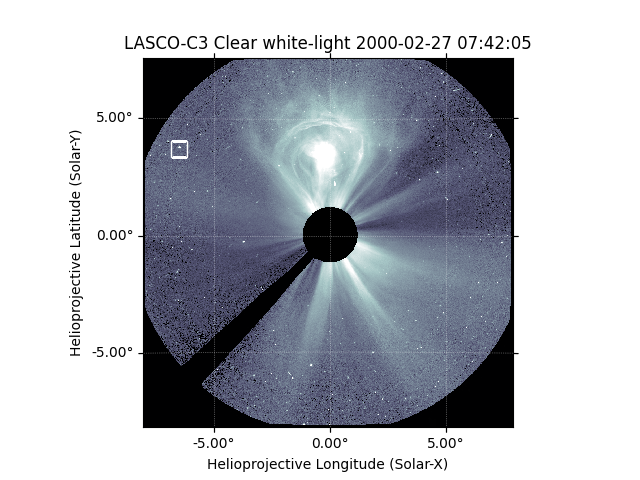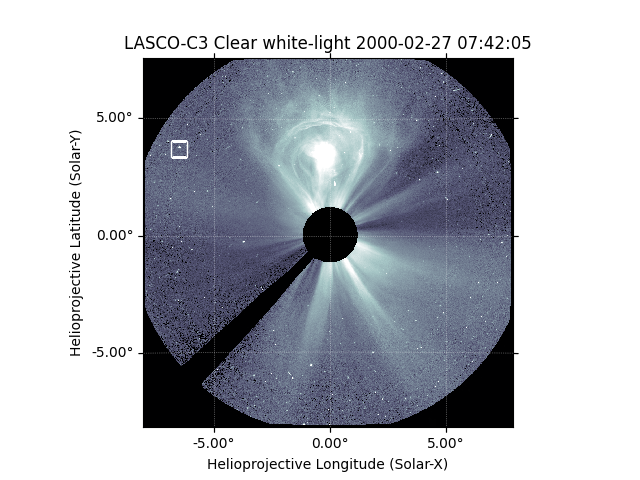Note
Go to the end to download the full example code
Setting the correct position for SOHO in a LASCO C3 Map#
How to get the correct location of SOHO using JPL HORIZONS and update the header.
This requires the installation of the
astroquery
package and an internet connection.
astroquery can be installed on-top of
the existing sunpy conda environment: conda install -c astropy astroquery
import hvpy
import matplotlib.pyplot as plt
import numpy as np
import sunpy.map
from sunpy.coordinates.ephemeris import get_body_heliographic_stonyhurst, get_horizons_coord
from sunpy.time import parse_time
from sunpy.util.config import get_and_create_download_dir
Let’s download a SOHO/LASCO C3 image Helioviewer.org and load it into a Map. The reason to use Helioviewer.org is that they provide processed images. We download to the default sunpy download directory.
lasco_file = hvpy.save_file(hvpy.getJP2Image(parse_time('2000/02/27 07:42').datetime,
hvpy.DataSource.LASCO_C3.value),
get_and_create_download_dir() + "/LASCO_C3.jp2")
lasco_map = sunpy.map.Map(lasco_file)
A user warning let’s you know that there is missing metadata for the observer location. sunpy goes ahead and assumes that the observer is at Earth.
print(lasco_map.observer_coordinate)
/home/docs/checkouts/readthedocs.org/user_builds/sunpy/checkouts/stable/examples/units_and_coordinates/getting_lasco_observer_location.py:40: SunpyMetadataWarning: Missing metadata for observer: assuming Earth-based observer.
For frame 'heliographic_stonyhurst' the following metadata is missing: dsun_obs,hglt_obs,hgln_obs
For frame 'heliographic_carrington' the following metadata is missing: dsun_obs,crln_obs,crlt_obs
print(lasco_map.observer_coordinate)
<SkyCoord (HeliographicStonyhurst: obstime=2000-02-27T07:42:05.810, rsun=695700.0 km): (lon, lat, radius) in (deg, deg, km)
(0., -7.18539124, 1.48139588e+08)>
To check that this worked let’s get the location of Mercury in this exposure and show that it is in the correct location.
mercury_wrong = get_body_heliographic_stonyhurst(
'mercury', lasco_map.date, observer=lasco_map.observer_coordinate)
mercury_hpc_wrong = mercury_wrong.transform_to(lasco_map.coordinate_frame)
print(mercury_hpc_wrong)
INFO: Apparent body location accounts for 330.72 seconds of light travel time [sunpy.coordinates.ephemeris]
INFO: Missing metadata for solar radius: assuming the standard radius of the photosphere. [sunpy.map.mapbase]
<Helioprojective Coordinate (obstime=2000-02-27T07:42:05.810, rsun=695700.0 km, observer=<HeliographicStonyhurst Coordinate (obstime=2000-02-27T07:42:05.810, rsun=695700.0 km): (lon, lat, radius) in (deg, deg, m)
(0., -7.18539124, 1.48139588e+11)>): (Tx, Ty, distance) in (arcsec, arcsec, km)
(-23270.61112792, 13370.26466196, 99146796.1462121)>
Let’s plot how this looks with the incorrect observer information.
fig = plt.figure()
ax = fig.add_subplot(projection=lasco_map)
# Let's tweak the axis to show in degrees instead of arcsec
lon, lat = ax.coords
lon.set_major_formatter('d.dd')
lat.set_major_formatter('d.dd')
ax.plot_coord(mercury_hpc_wrong, 's', color='white',
fillstyle='none', markersize=12, label='Mercury')
lasco_map.plot(axes=ax)
plt.show()

SOHO is actually a halo orbit around the Sun–Earth L1 point, about 1 million km away from the Earth. The following functions queries JPL HORIZONS which includes positions of major spacecraft. This function requires an internet connection to fetch the ephemeris data.
soho = get_horizons_coord('SOHO', lasco_map.date)
INFO: Obtained JPL HORIZONS location for SOHO (spacecraft) (-21) [sunpy.coordinates.ephemeris]
For fun, let’s see how far away from the Earth SOHO is by converting to an Earth-centered coordinate system (GCRS).
print(soho.transform_to('gcrs').distance.to('km'))
1352065.7329907273 km
Let’s fix the header.
lasco_map.meta['HGLN_OBS'] = soho.lon.to('deg').value
lasco_map.meta['HGLT_OBS'] = soho.lat.to('deg').value
lasco_map.meta['DSUN_OBS'] = soho.radius.to('m').value
Let’s get the right position now.
mercury = get_body_heliographic_stonyhurst(
'mercury', lasco_map.date, observer=lasco_map.observer_coordinate)
mercury_hpc = mercury.transform_to(lasco_map.coordinate_frame)
INFO: Missing metadata for solar radius: assuming the standard radius of the photosphere. [sunpy.map.mapbase]
INFO: Apparent body location accounts for 326.33 seconds of light travel time [sunpy.coordinates.ephemeris]
The difference between the incorrect position and the right one is:
r = np.sqrt((mercury_hpc.Tx - mercury_hpc_wrong.Tx) ** 2 +
(mercury_hpc.Ty - mercury_hpc_wrong.Ty) ** 2)
print(r)
0.4271595231009972 arcsec
Let’s plot the results.
fig = plt.figure()
ax = fig.add_subplot(projection=lasco_map)
# Let's tweak the axis to show in degrees instead of arcsec
lon, lat = ax.coords
lon.set_major_formatter('d.dd')
lat.set_major_formatter('d.dd')
ax.plot_coord(mercury_hpc, 's', color='white', fillstyle='none', markersize=12, label='Mercury')
lasco_map.plot(axes=ax)
plt.show()

Total running time of the script: (0 minutes 1.588 seconds)